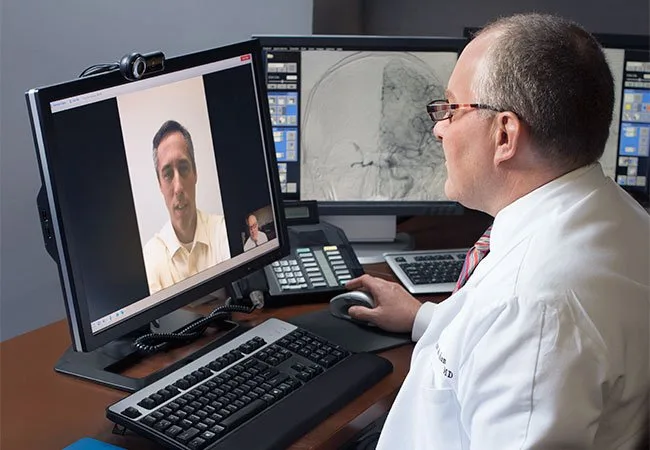With virtual medical appointments becoming more popular amid physical distancing measures, an expert from a top American hospital, Cleveland Clinic, has advice on what conditions are suitable for virtual visits and how to prepare for them.
The world is going virtual
“Virtual visits allow us to address patients’ health concerns, safely and effectively,” says family medicine doctor Mark Rood, MD. Here, Dr. Rood explains how they work and what to expect.
Which conditions are suitable for virtual medical visits?
Online, doctors are having consultations with patients that cover a number of common illnesses and injuries. “We can treat lots of problems virtually,” says Dr. Rood.
These conditions include fevers, rashes, cold and flu, mild COVID-19 symptoms, aches and pains, minor musculoskeletal injuries, infections such as pink eye or strep throat, and even uncomplicated urinary tract infections.
Dealing with stress and anxiety
“We’ve also had patients call with overwhelming stress and anxiety as a result of the pandemic,” he adds. “We can help them work through those emotions and connect them to options for ongoing care.”
During your virtual appointment, your healthcare provider will ask about your concerns and symptoms. They might do a visual exam and look you over for rashes or other physical abnormalities. Sometimes, your provider may recommend that you make an appointment for an in-person test or exam. However, Dr. Rood says, in many cases, virtual visits are all you need to address less pressing health concerns.
Managing chronic illness with virtual medical consultations
Patients who manage ongoing health conditions like high blood pressure, heart disease, diabetes, and arthritis can also benefit from telemedicine. “We can help our patients monitor their chronic conditions remotely,” Dr. Rood says.
You can even buy devices to use at home to measure heart rate, blood pressure, and weight. The devices automatically upload the data to your medical chart for your doctor to review. “Technology has really advanced in the past two or three years to allow us to do things we’ve never done before,” Dr. Rood says.
And even if you do not purchase such devices, your healthcare provider may be able to monitor your symptoms or adjust your medication without an in-person visit. “It’s worth talking to your primary care doctor or specialist to see if they can perform a virtual visit,” Dr. Rood says.
Tips for making virtual visits successful
Virtual medical visits do not have to be cold or chaotic, said a colleague of Dr. Rood at Cleveland Clinic and family medicine specialist Neha Vyas, MD. She has the following tips to ensure that they go as smoothly as possible.
- Make sure you are available before your virtual medical appointment to answer any questions that your doctor or healthcare provider’s assistant might have. In some cases, your provider’s office might call between 15-20 minutes before your appointment, or they might call the day before. Basically, you will be asked the same questions you are asked during a routine in-person checkup. Also, be sure to take your medications nearby, so you can refer to them. Having the most up-to-date information is critical to your health.
How to set yourself up for your consultation
- During your virtual visit, place your phone, tablet, or computer on a level surface instead of holding it while speaking to your provider. Make sure your provider can see your face and your upper chest. Unless you are really feeling poorly, try to stay upright and seated during your visit and do not move from one room to another. This will allow the provider to evaluate you the same way they do in the office. When you are speaking, your doctor or specialist will examine the way your chest moves and if your facial muscles are moving synchronously.
Be prepared
- Similar to taking photos, make sure that the light source in the room is to the side or above and not behind you. It is difficult to see patients when they are sitting in front of a window with the shades open. Also, make sure that your camera screen is free from dirt for the best possible visual inspection.
- Be sure to have paper and a pen with you so you can take notes during the visit. It is also helpful to have a penlight or a flashlight on-hand so that you can spotlight areas on your body where you may have a rash or injury. Or you can take a picture of the affected area and ask the assistant how to send it to your medical provider.
Manage your virtual medicine space
- Avoid having virtual visits to a room with background noise, such as in a kitchen, or with a pet nearby. If possible, have someone else care for young children or animals in another room so you and your provider can focus on your visit.
- Unless they are in the room to assist or provide additional information for your virtual visit, ask guests or family members to wait in another room until your appointment is over. Since sensitive information will be discussed during your visit, this can help protect your privacy.
- Keep in mind that the audio may be delayed on your end or your provider’s. This can cause the flow of your conversation to be a bit slower. Use shorter sentences and allow more pauses in the conversation so that your medical provider does not miss anything you say.
About Cleveland Clinic
Cleveland Clinic is a nonprofit multi-specialty academic medical center that integrates clinical and hospital care with research and education. Located in Cleveland, Ohio, it was founded in 1921 by four renowned physicians with a vision of providing outstanding patient care based upon the principles of cooperation, compassion, and innovation.



![women [longevity live]](https://longevitylive.com/wp-content/uploads/2020/01/photo-of-women-walking-down-the-street-1116984-100x100.jpg)










